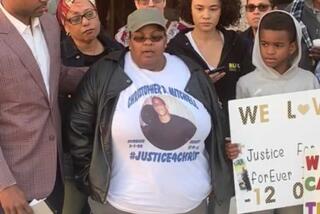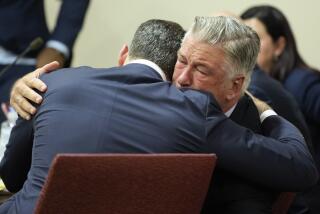Judge Rejects Bid to Dismiss Simpson Case
- Share via
Superior Court Judge Lance A. Ito on Monday rejected an attempt to have the murder case against O.J. Simpson dismissed, ruling instead that enough evidence exists to force the football hero to stand trial in the slayings of his ex-wife and her friend.
Ito also echoed a ruling by a Municipal Court judge who found that a warrantless search of Simpson’s estate hours after the killings was legal because officers said they were concerned that other victims might be inside and need help.
“The detectives in this situation were confronted with a brutal and violent killing, multiple killings,” Ito said, adding that the officers encountered a number of troubling signs when they arrived at the house before dawn June 13.
“Under those circumstances, I feel that the actions by the detectives were justified,” Ito said.
Motions to dismiss criminal cases at this stage rarely are granted, and defense attorneys had not held out much hope of succeeding in the Simpson case, so Ito’s ruling Monday was widely predicted.
The hearing did, however, include a detailed description of the prosecution’s version of the killings as well as of the latest surprise development in the unfolding murder mystery: Prosecutors revealed that they want to put Simpson’s longtime assistant, Cathy Randa, on the witness stand to ask her when and why she shredded documents found during a search of Simpson’s office.
According to prosecutors, the documents discussed domestic abuse and were spotted by a Los Angeles police detective executing a search warrant in connection with the investigation of Simpson’s friend Al Cowlings, who was arrested on suspicion of aiding the football legend when police believe he was trying to flee prosecution.
Robert L. Shapiro, one of Simpson’s lead attorneys, said later that the material consisted of pamphlets and brochures about domestic violence that Simpson received years ago as part of his court-ordered therapy after a 1989 incident in which he pleaded no contest to spousal battery.
The detective attempted to seize the documents Aug. 12, according to Deputy Dist. Atty. Marcia Clark, but was prevented from taking them by one of Simpson’s lawyers and by a special court-appointed master supervising the execution of the search warrant. When the officer returned two weeks later with a warrant specifically authorizing him to seize the documents, Randa told him she had shredded them.
Ito seemed taken aback by the disclosure, exclaiming, “Just when I think there are no more surprises!” But he agreed that Randa could be asked about the shredding and recommended that she have a lawyer with her when she appears.
She could be asked to testify as soon as Wednesday, when lawyers will return to the courtroom to argue the defense’s motion to suppress evidence seized in various searches of Simpson’s home, cars and office.
That issue also touches another volatile topic in the case, however. Defense attorneys maintain that prosecutors are improperly using the grand jury investigating Cowlings to conduct further investigation of Simpson, and they will argue later this week that any evidence gathered from Simpson’s office should be excluded from his case.
“This could hurt both sides in different ways,” said Peter Arenella, a UCLA law professor. “It allows the defense to strengthen their case that the grand jury investigating Al Cowlings is really being used to investigate O.J. Simpson. . . . At the same time, it raises the question of why this document was shredded. You don’t normally end an argument about an issue like this by destroying evidence.”
Before ruling on the motion to dismiss the case, Ito heard more than two hours of arguments from lawyers on both sides. Simpson, who was in court Monday and spent much of the hearing taking notes or chatting with attorney Johnnie L. Cochran Jr., has pleaded not guilty to the murders of Ronald Lyle Goldman and Nicole Brown Simpson. If convicted, he could face life in prison without possibility of parole.
Shapiro argued that the prosecution had failed to present a coherent theory of the murders during the preliminary hearing, that certain aspects of the prosecution case do not square with each other and that sloppy investigative work has made it impossible for Simpson to defend himself.
“Because the Los Angeles Police Department detectives on the scene did not follow departmental-approved policy and did not notify the coroner for 10 hours after the bodies had been seized . . . we are forever excluded from knowing what the time of death was,” Shapiro said. “We have been left in a position where the people have deprived us of the absolute right to put on any real defense to this case.”
Elaborating on arguments first aired during the preliminary hearing, Shapiro and Simpson lawyer Gerald F. Uelmen hammered Monday on a number of instances in which they maintain that police and other investigators slipped up. Uelmen, for instance, accused one of the LAPD detectives of lying five times in preparing an affidavit for a warrant to search Simpson’s home.
That affidavit, Uelmen said, shed light on the detectives’ motives during their initial search of Simpson’s estate. Although detectives later said they had jumped the fence surrounding Simpson’s property in part because they were concerned about other possible victims inside, the affidavit contains no reference to entering the property without a warrant.
Citing that and other statements in the affidavit, Uelmen said it “gives a very different account than the account presented in the carefully orchestrated testimony that we heard at the preliminary hearing.”
Clark conceded that there were mistakes in the affidavit--at several points, Detective Philip L. Vannatter refers to red spots as “human blood” when that determination was not made until after the warrant was obtained--but she said the errors were harmless. Even if the errors were corrected, she said, it would not have affected a judge’s willingness to issue the warrant.
Clark also took aim at the recurring defense contention that a single person could not have committed the killings. She said crime scene evidence in fact suggests that a single killer was responsible, and she maintained, as prosecutors have throughout, that the culprit was Simpson.
“You have blood drops accompanied by bloody shoe prints,” she said. “You see only one set of shoe prints leaving that crime scene, not two, leading us to understand that . . . there can only be one perpetrator.”
In their effort to persuade Ito to dismiss the case, Simpson’s attorneys consistently have focused on what they say are flaws in the case against their client--a theme they reiterated during Monday’s hearing. Among other things, they said that whoever committed the killings would almost certainly have been covered in blood, since both victims were repeatedly slashed and stabbed with a knife and their bodies found lying in deep pools of their own blood.
“There is no evidence that Mr. Simpson had any blood on him,” Shapiro said. “There is no evidence of any bloody clothing being found.”
In addition, Shapiro maintained that it was absurd to believe that Simpson would have carefully discarded certain pieces of evidence, such as bloody clothing and the murder weapon, and then stupidly brought a bloody glove back to his own home and left it there.
“One would have to believe that somebody who was careful enough to get rid of all those items of evidence in a very short period of time would nevertheless leave one glove at the murder scene and deliberately bring home and leave on his own property a glove that could later be discovered in plain view by anyone who was walking on the property,” Shapiro said. “These are questions that the prosecution must answer, your honor.”
Those accusations prompted Clark to deliver a detailed description of the prosecution’s version of the killings. Her account echoed the version told for months by sources close to the case, but it marked the first time that prosecutors have laid it out in such detail, and it highlighted the prosecution’s theory that Simpson meticulously plotted the murder of his ex-wife and only killed Goldman because the young man came upon the scene to return a pair of glasses to Nicole Simpson.
“Murder is a messy thing, your honor,” Clark said. “There was only one intended target, and that was Nicole Brown. When Ron Goldman showed up, that was something the defendant didn’t bargain for.”
According to Clark, Goldman and Simpson fought. It was in that struggle that Simpson lost one glove, was cut and had his cap pulled off, she said.
“Evidence was . . . left at the scene because it could not be seen by the defendant in the heat of the moment,” Clark argued. “It was dark, and in point of fact, we see that the ski cap and the glove are underneath a plant. Did he look for them? He probably did, but there was no time to root around that crime scene in order to find evidence. He had to get out and get out fast.”
Those mistakes do not suggest that Simpson did not plan the crime or that he did not commit it, Clark added: “The fact that a defendant makes mistakes, leaving evidence behind that allows the police to apprehend him is not the surprise, because if he didn’t, he would never be caught. . . . If mistakes are not made, criminals are not apprehended.”
Simpson’s lawyers also filed a motion Monday asking Ito to sanction prosecutors for failing to move more quickly on DNA tests that could prove crucial to the case.
According to that motion, the Maryland lab running the bulk of the tests has completed its work on at least five blood samples--two taken from Simpson’s home, two from the blood trail near the murder scene and one from Goldman’s shoe.
Sources have said results from the tests completed so far suggest a match between the blood drops at the scene and Simpson’s blood, while the blood on Goldman’s shoe was not from Simpson but rather from the victims. The two drops taken from Simpson’s home also appear to match his blood, but those samples are considered less relevant to the charges against him.
In addition, genetic fingerprint tests of two other drops found near the victims were inconclusive. Other DNA tests still may be performed on those items to determine whether those tests yield conclusive findings.
With jury selection scheduled to begin Monday, Ito still has not decided whether panelists will be fully sequestered for the duration of the trial, which some have estimated could last six months.
The process of contacting prospective jurors already is under way. About 500 have returned questionnaires that inquire about their ability to serve on the case until at least February. The one-page questionnaires ask the jurors if a hardship would be presented if they were partially sequestered--kept away from others during the day and allowed to go home at night--or fully sequestered--put up in a hotel for the duration of the trial.
The prosecution has asked Ito to fully sequester the jury once it is picked to keep it away from what is expected to be unprecedented media coverage.
The defense has opposed that proposal in a sealed motion. Experts have said that full sequestration might narrow the diversity of the jury, given that the only people who could serve would be those who could be away from their jobs and families for an extended period. In addition, according to experts, fully sequestered juries often lean toward the prosecution.
In addition to the one-page hardship questionnaires, jurors will be asked to fill out extensive questionnaires intended to give Ito and the lawyers some indication of prospective jurors’ suitability to be on the panel. That process may begin as early as next week.
More to Read
Sign up for Essential California
The most important California stories and recommendations in your inbox every morning.
You may occasionally receive promotional content from the Los Angeles Times.














